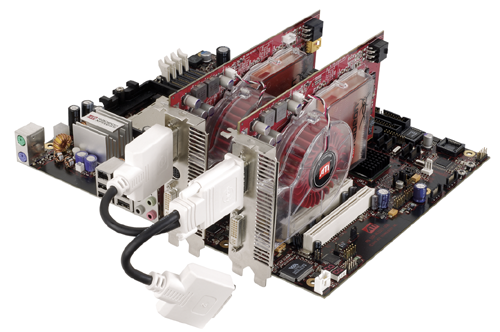ATI's Multi-GPU Solution: CrossFire
by Anand Lal Shimpi & Derek Wilson on May 30, 2005 9:00 PM EST- Posted in
- GPUs
ATI's Answer to SLI: CrossFire (The Card)
ATI does not have dedicated silicon on their GPUs for chip-to-chip communications as NVIDIA does. ATI bills this as a positive aspect of their solution, as their CrossFire solution is capable of running cards with two different (and even different speed) GPUs. NVIDIA's SLI solution is restricted to running on not only the same model of card, but cards with the same video BIOS. Timing is crucial when hooking the two GPUs together for SLI. In fact, an out-of-spec SLI bridge can even cause problems. We will only be able to see which solution performs better when we get hardware in our hands, but if all things are equal, ATI will have the advantage here.
In order to make up for their lack of a chip-to-chip interconnect, ATI includes a Compositing Engine chip on their CrossFire card. Because of this, the CrossFire card can be paired with any Radeon X800 or X850 (there will be a CrossFire card for each flavor). The driver controls clock speeds of each card automatically and manages synchronization as necessary. Synchronizing boards can be done on a general scale and doesn't need to be clock for clock. All CrossFire cards have 16 pixel pipelines, but disable 4 pipelines when running in tandem with a 12 pipe Radeon. This is what allows ATI to provide a limited number of CrossFire cards to work with multiple Radeons. Each card does need its own x16 PCI Express slot, and the boards communicate through an external cable.

This may look more like the older 3dfx SLI solution, but in reality, the Radeon X800 or X850 sends its data digitally from the DVI output to the input on the CrossFire card, which then handles the data and forwards the final frame to the display device. Under alternate frame rendering (AFR), the data is simply sent on unchanged, but the Compositing Engine handles the combination of a split or supertiled frame, as well as the final rendering of ATI's super AA modes (more on these later).

In order to function properly, the standard and CrossFire cards share some system RAM. This allows each card access to all necessary data that doesn't need to be unique for each frame. ATI's driver handles splitting the workload and configuring a unique command queue for each card based on the application and the rendering mode selected. Rendering modes are not user selectable, and are predetermined through Catalyst AI. Each card also has access to its own system memory as usual.










57 Comments
View All Comments
Calin - Tuesday, May 31, 2005 - link
"ATI should be focused on the overall platform, not necessarily building up support for their South Bridge. Although we do think it is a bit embarrassing to have to turn to another chipset vendor to provide working South Bridges for your motherboard partners. It would be one thing if this were ATI's first chipset, but it most definitely is not. "AMD first chipset (AMD 760 for Slot A Athlon, or Irongate, I think) had also non working USB support (or very buggy). Most mainboard manufacturers offered USB thru an add in PCI card, in order not to use the one included in the southbridge
Googer - Tuesday, May 31, 2005 - link
In theroy since It connets to the other card through DVI, I could use my old 9700pro in Crossfire mode with the newer card; even better is what if I could use an NVIDA card and ATI card in Crossfire! All I need is that moterhboard (if forgot the make and model) that supports PCI-e and Ture AGP! (not pci based agp)FakeName - Tuesday, May 31, 2005 - link
This is bogus, remember accelerator cards, mid-90's... poor solution then, same poor solution again... don't waste your hard earned money on this cerebral shortfall, the next gen will soon be upon us...Shinei - Tuesday, May 31, 2005 - link
Performance looks promising, sure, but I wonder what will be shown when AT gets hold of a sample for longer than a few benchmark runs--an 85% improvement at 1600x1200 seems a bit strange, particularly for hardware known for wheezing in the benchmarked game...CrystalBay - Tuesday, May 31, 2005 - link
Very sophisticated approach ATI...Hopefully the Composter doesn't turn to sh!t later on...sprockkets - Tuesday, May 31, 2005 - link
Hmmm, isn't the current SB on existing Radeon Express 200 boards buggy too?overclockingoodness - Tuesday, May 31, 2005 - link
#15: Regardless, what difference does it make? The performance would still be closer to what's presented in the article.overclockingoodness - Tuesday, May 31, 2005 - link
#15: You need to read more carefully. Notice how they said that it was the vendor's PC and not their own. So, obviously they had no choice. They had to go by whatever the vendor was offering at the time.flatblastard - Monday, May 30, 2005 - link
I was a little bummed after reading that the Crossfire + Xpress 200 would also have 2xPCI-e slots instead of just one like the current msi rs480m2-il. I was even more disappointed to here about the current state of the sb450. I thought the sb450 was supposed to fix the bugginess of sb400 which it is replacing? Oh well, no big suprise I guess considering their history in that department. So here's hoping for another save from uli.bob661 - Monday, May 30, 2005 - link
#16They weren't listed so I would imagine that they won't be compatible.